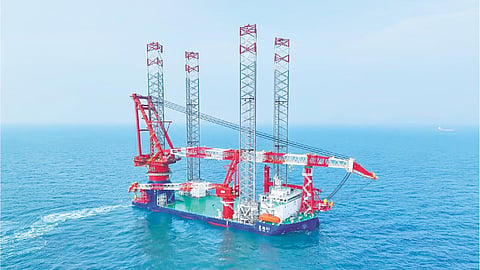VESSEL REVIEW | Lankun 01 – Shandong Marine’s newest installation jackup boasts 1,500-tonne lifting capacity
Shandong Lankun Marine Engineering, a subsidiary of Chinese state-owned conglomerate the Shandong Marine Group, recently took delivery of a new self-elevating platform (SEP) fitted with a heavy duty offshore crane built by the Wison Group to a design by the 708 Research Institute of the China Shipbuilding Group (CSG). Lankun 01 (藍鲲01) will be used primarily for the transport and installation of offshore wind turbines and their associated components in both coastal and deep-sea waters.
The all-steel SEP has an LOA of 135 metres (443 feet), a beam of 50 metres (160 feet), and a depth of 10 metres (30 feet). The vessel also has four piling legs and four separate rack and pinion lifting systems. The legs can be extended to enable installation works at depths of as much as 70 metres (230 feet) while the fully rotating, leg encircling crane can lift 1,500 tonnes up to a maximum height of 170 metres (560 feet), making it ideal for use with large wind turbines of 16 to 20 MW output.
Electric propulsion combined with ample liveaboard spaces
The platform is equipped with an electric propulsion system supplied by CSG subsidiary 712 Research Institute. The arrangement consists of six 2,500kW high-voltage generators, three 2,600kW azimuthing thrusters at the stern, and three 1,600kW bow thrusters. The propulsion delivers a service speed of just over four knots while the manoeuvring thrusters operate in conjunction with the vessel’s DP2 system to enable highly accurate positioning prior to commencing installation works under light to moderate wave conditions.
The crew accommodation spaces include 32 single cabins including four suites, 26 double cabins, and nine quadruple cabins housing a total of 120 berths. The other onboard facilities are dry and cold storage rooms, changing rooms, laundry areas, mess areas, galleys, medical bays, offices, conference rooms, toilets, recreation centres, and fitness areas. The interiors have all been configured to minimise noise and vibration to satisfy Maritime Labour Convention requirements.
Also suited for other installation works
The SEP adopts a streamlined bow, a square stern, and an open working deck amidships. The accommodation block is located at the bow while the 1,500-tonne main crane is offset to starboard at the stern to ensure as much continuous deck space as possible for the transport of large wind turbine components.
Design work on Lankun 01 was completed in compliance to both China Classification Society and China Maritime Safety Administration requirements. In addition to installing wind turbines, the vessel may also take on secondary duties such as marine construction.


